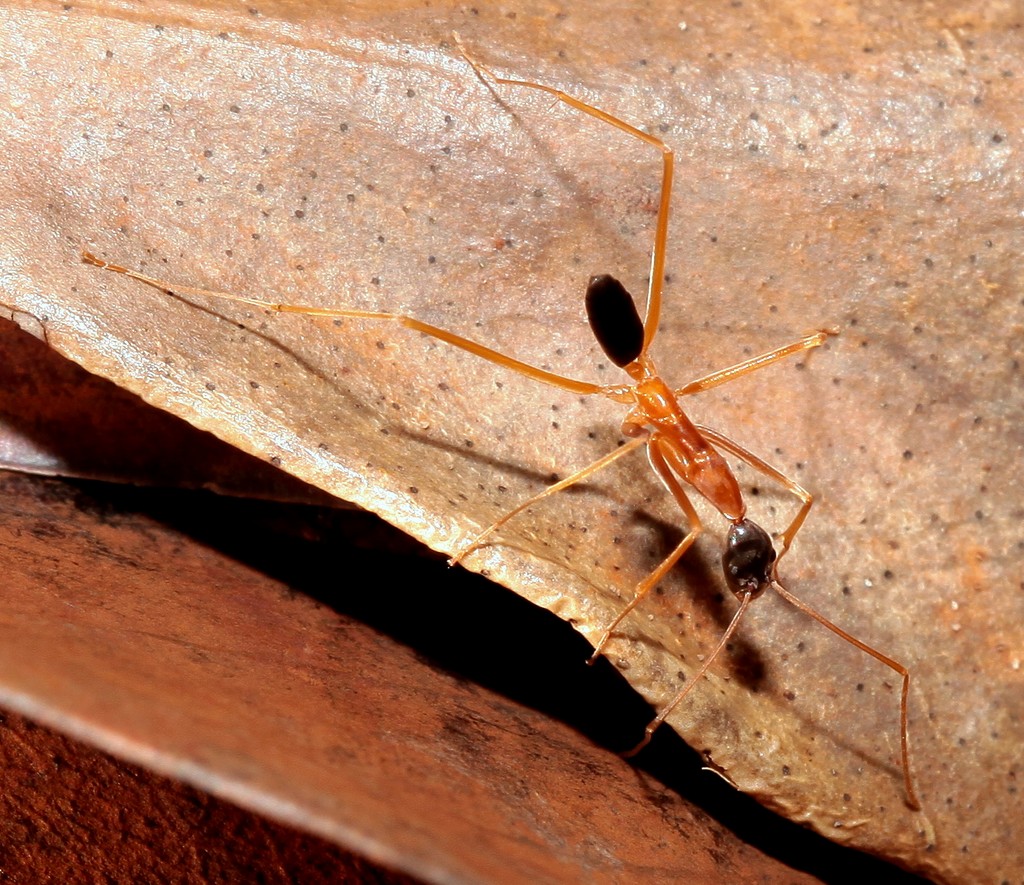LEPTOMYRMEX NIGRICEPS - (EMERY, 1914)
Class: Insecta > Order: Hymenoptera > Family: Formicidae > Subfamily: Dolichoderinae > Genus: Leptomyrmex
Description
Worker measurements
HL 1.68–1.90, HW 0.92–1.01, MFC 0.20–0.25, IOD 0.54–0.60, SL 3.17–3.47, EL 0.29–0.36, WL 3.03–3.41, PW 0.75–0.86, DPW 0.27–0.33, HTL 3.57–4.11, HTWmin 0.10–0.14, HTWmax 0.14–0.18, CI 0.52–0.56, SI 3.27–3.56, OI 0.08–0.10, HTC 0.65–0.95.
Worker description
Leptomyrmex nigriceps is a small species with elongate head nearly twice as long as broad, excluding mandibles (CI 0.54–0.57). Sides of head parallel, slightly convex, posterior to eyes head narrowing gently to flat postocular margin. Approximately 15 teeth and denticles interspersed on masticatory margin of mandible. Anterior clypeal margin flat to weakly concave. Eyes positioned approximately at midline of head, relatively large, convex, hairless, not reaching the lateral margins of head. Antennae extremely slender, but not compressed. Scapes extending past the posterior margin by 2/3 their length.
Pronotum elongate. Propodeum short, dorsal face about 1.5 times as long as the convex declivitous face, angle rounded. Dorsal face of propodeum convex, with a transverse impression at the anterior end. Petiolar node small, triangular in profile with a rounded dorsum. Anterior, dorsal and posterior face of petiole with longitudinal impression posterior face longer than anterior, ventral surface flat. Gaster broadly elliptical. Legs very slender, not compressed (HTC 0.61–0.85).
Femora unicolorous pale and head black. Gaster and head, excluding mandibles and antennae, black, with remainder of body pale orange.
Biology
Leptomyrmex nigriceps resembles the other two New Caledonian Leptomyrmex (Leptomyrmex pallens and Leptomyrmex geniculatus) but can be recognized by its distinctive color pattern: dark head and gaster on an otherwise orange body. This species appears to be restricted to the ultramafic southern tip of the island, where it occurs in sympatry or parapatry with Leptomyrmex pallens.
Leptomyrmex nigriceps has been recorded in rainforest, Agathis woodland, cloud forest and low, closed riparian forest. Nests have been found in rotting stumps.
Synonymes
Leptomyrmex pallens var. nigriceps (Emery, 1914)
Leptomyrmex pallens subsp. nigriceps (Emery & Wheeler 1934)
Description
Worker measurements
HL 1.68–1.90, HW 0.92–1.01, MFC 0.20–0.25, IOD 0.54–0.60, SL 3.17–3.47, EL 0.29–0.36, WL 3.03–3.41, PW 0.75–0.86, DPW 0.27–0.33, HTL 3.57–4.11, HTWmin 0.10–0.14, HTWmax 0.14–0.18, CI 0.52–0.56, SI 3.27–3.56, OI 0.08–0.10, HTC 0.65–0.95.
Worker description
Leptomyrmex nigriceps is a small species with elongate head nearly twice as long as broad, excluding mandibles (CI 0.54–0.57). Sides of head parallel, slightly convex, posterior to eyes head narrowing gently to flat postocular margin. Approximately 15 teeth and denticles interspersed on masticatory margin of mandible. Anterior clypeal margin flat to weakly concave. Eyes positioned approximately at midline of head, relatively large, convex, hairless, not reaching the lateral margins of head. Antennae extremely slender, but not compressed. Scapes extending past the posterior margin by 2/3 their length.
Pronotum elongate. Propodeum short, dorsal face about 1.5 times as long as the convex declivitous face, angle rounded. Dorsal face of propodeum convex, with a transverse impression at the anterior end. Petiolar node small, triangular in profile with a rounded dorsum. Anterior, dorsal and posterior face of petiole with longitudinal impression posterior face longer than anterior, ventral surface flat. Gaster broadly elliptical. Legs very slender, not compressed (HTC 0.61–0.85).
Femora unicolorous pale and head black. Gaster and head, excluding mandibles and antennae, black, with remainder of body pale orange.
Biology
Leptomyrmex nigriceps resembles the other two New Caledonian Leptomyrmex (Leptomyrmex pallens and Leptomyrmex geniculatus) but can be recognized by its distinctive color pattern: dark head and gaster on an otherwise orange body. This species appears to be restricted to the ultramafic southern tip of the island, where it occurs in sympatry or parapatry with Leptomyrmex pallens.
Leptomyrmex nigriceps has been recorded in rainforest, Agathis woodland, cloud forest and low, closed riparian forest. Nests have been found in rotting stumps.
Synonymes
Leptomyrmex pallens var. nigriceps (Emery, 1914)
Leptomyrmex pallens subsp. nigriceps (Emery & Wheeler 1934)
